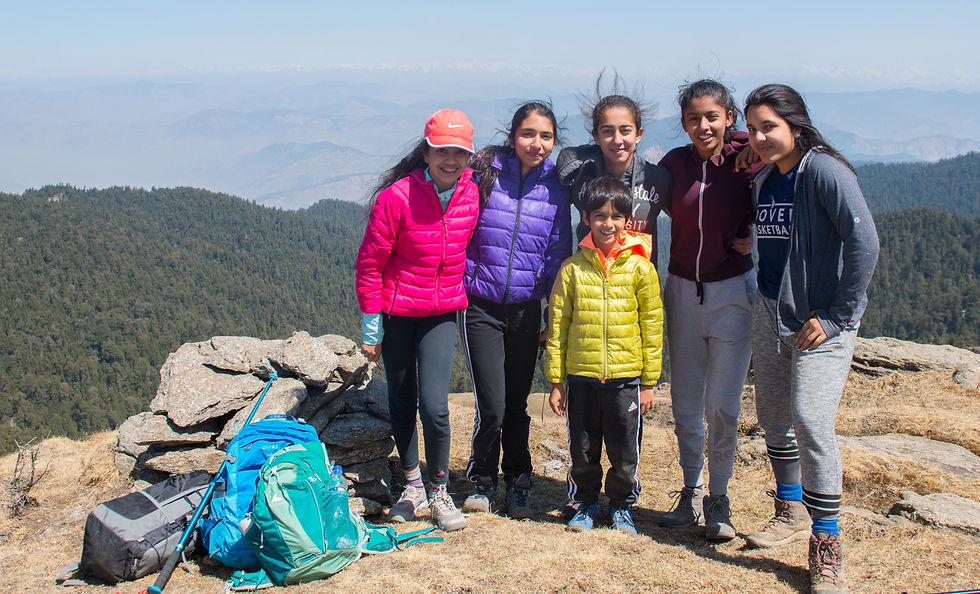Summitting Island Peak
- Juniper

- Sep 11, 2019
- 4 min read
Ramesh Venkataraman visted Everest Base Camp - Nepal with Juniper in April 2019. In this article, Ramesh shares the events of his adventurous climb to the Island Peak.
Belly crawling up an ice slope is not a recommended mountaineering technique. This much was clear to me when at 8 am on the freezing morning of Friday, May 3, a party of hardy Russian climbers looked on bemused as I attempted to jumar up the fixed rope on the final 70° head wall to the summit of Island Peak whilst lying stomach down against the slope. I had just crawled over the ladder across the final crevasse and was totally exhausted and not particularly receptive to a lesson in mountaineering technique, having been on the climb for nearly eight hours!
The 6189 m Island Peak is an extension of the ridge coming down off the south end of Lhotse, the magnificent mountain alongside and to the south and east of Everest. Known locally as ImjaTse, the mountain was named Island Peak in 1953 by members of the British Mount Everest expedition because it appears as a somewhat isolated massif amidst several impressive peaks when viewed from the trail leading to it from the village of Chukkung. The peak was later renamed in 1983 to ImjaTse but Island Peak dominates popular usage.

Our hardy party of four - Varun, Jahnavi, Jasmine and I – had set off from Dingboche for Chukkung on April 30 after bidding goodbye to the rest of the EBC group. The teahouse at Chukkung proved to be a delightful halt - so much so that with bad weather approaching we decided to stay an extra night there rather than brave the rigours of base camp at 5300 m for 2 nights. However, whilst this ensured hot food and a warm bed for one more day, it meant that we compromised our training in rappelling and particularly jumaring – resulting in my need for an in situ Slavic coaching lesson on the ice slope at 6000m.
We had left Base Camp just after midnight on May 3. The initial trail was very very rocky and there were a few scary scrambles required in complete darkness but we made reasonable time under clear skies. We passed High Camp at 5600m at around 2.30 am and I got to crampon point around 4.30 am just as the lovely dawn light was breaking out (having harnessed up just before to scramble across an exposed ridge in stiff wind). This was more or less to plan since we had been advised by prior summiteersto target reaching here by 4 am. (Incidentally, very few climbers use High Camp to launch their summit attempt since it lacks any water source and only cuts the total climbing time from Base Camp by a bit more than a couple of hours.)

The initial hour after crampon point was on pristine, snow-covered slopes marked by deep crevasses that we crossed using four rickety ladders and a couple of standing long jumps. On my way up, I was mostly focused on the technique of placing the crampons correctly on the ladder rungs and didn’t have time to worry about the what ifs, but on the way back I realised how scary a couple of these crossings were especially one over a narrow ice bridge that was ominously cracked half way through.
The crampon walk itself was relatively brisk and I reached the beautiful bowl below the head wall by 6ish with Lakpa (our Sherpa guide who had been us with through the entire EBC trek) and Ngima (our local guide).
This is when things got really tough – perhaps the hardest thing that I have ever done. The ice wall is 220m in vertical height and its slope ranges between 50° and 70° so its actual length is close to 300+ m. As different from the videos circulated before the trek, the new route brings you very close to the summit leaving only a 30 ft narrow ridge to traverse after the head wall - but negotiating the ice slope itself took nearly 3 hours and a zillion calories.
Finally, aided by the tips from the Russians on adopting a more recognizable jumaring stance, I made it to the top of the ridge and then quickly onto the summit at 9.15. The atmosphere on top was eerily tranquil and, perhaps because I had made it in the window just after the speed devils but before the late starters, I was let alone to sit on the precariously small peak area, taking in the amazing 360° views, and savouring the moment for nearly 30 minutes. The Lhotse south face was close enough to touch and the entire ring of mountains to the south and the treacherous AmphuLapcha were clearly visible – although sadly Makalu was smothered by clouds.

Descent was comparatively easy and I made it back to the bowl at the bottom of the ice wall by 11.15. I was by this point pretty knackered and took a break for 30 minutes before starting my slow trudge back to Base Camp which I reached at 4 pm, nearly 16 hours after we set out - thereby creating a template for the Slow Climbing movement.
An hour of rest and a quick lunch later, I followed the rest of the team on the 3-hour walk back to Chukkung since there were no arrangements for us to stay over that night at Base Camp and we were hoping to make the chopper from Chukkung the following morning. Given the snowy and overcast conditions due to cyclone Fani, we have had to come down another 2 hours to Dingboche on May 4 where the thick hot chocolate at Cafe 4401 and several rounds of bridge helped us sit out the weather until the eventual helicopter pick up on Sunday, May 5.



Comments